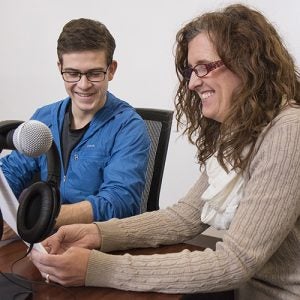SHARED EXPERIENCES
Students with learning differences show others the path to college
Patrick Young was told early in life that he was not college material; that he wouldn’t make it. He and his parents – especially his mother, who also grew up with dyslexia – thought otherwise.
“I was told ‘you should go become an electrician, a plumber’…that I would be happy with that,” said Young. “But I knew, and my parents pushed me to take the classes I needed to go to college.”
He and eight other students with learning disabilities began their first semesters at East Carolina University in 2014 as part of the Walter and Marie Williams STEPP Program (Supporting Transition and Education through Planning and Partnerships). The program helps students with learning disabilities navigate enrollment and transition to campus life. Now, Young and classmate Logan Darr want to help other students like them by sharing their experiences.
A pathway to success
“For me, (the greatest challenge) was the process of trying to find the right school that was the right fit for me that could help me in the right way.” said Darr, who was diagnosed with ADHD and put on medication when she was 6.
Darr has difficulty writing and with auditory processing, so she needs extra time for assignments and a quiet, solitary space to take exams. Quizzes and tests must be read to her, a service provided through ECU’s Disability Support Services department.
The STEPP Program helps students find services they need and provides peer and faculty support at ECU, but space in the program is limited to 10 new students per year.
Young feels lucky to have found STEPP.
“It’s more than just a program, it’s a family,” he said. “They guide you and help you as much as they can to be successful.”
Reaching out to others
To ensure that students with a learning difference have access to the same information and support, Darr and Young manage STEPP’s student blog and plan to expand it by adding podcasts and a YouTube channel.

Patrick Young and Dr. Sarah Williams discuss the introduction to the new podcast series.
“There are students out there that don’t have the knowledge, don’t have the support. They’re in a school system that doesn’t know how to help them specifically,” said Young. “Logan and I are working with the blog to try to get free information out there to high school and college students who don’t know how to get the help, or know what accommodations are available to them and how they can really succeed.”
Darr, an art major concentrating in graphic design, has been redesigning the site to improve navigation and user experience, as well as indexing blog topics. She also answers questions in the “Student to Student” section, where students can interact directly with the blog team.
Young manages the site and the team of five bloggers. He hopes to expand the number of writers and the audience, to make the blog more appealing to high school students.
Connecting with their audience
“We want the students to help guide the blog,” said Young. “We want to know how they are preparing for college, how they live their day to day lives with their disability and how the schools are helping them make it through.”
Their first podcast will be recorded on Nov. 30 and will discuss how to disclose a learning disability, its definition and what accommodations are available. Adding multimedia elements seemed a natural step for Young, because he has trouble reading.
“I don’t like to read,” said Young. “Why would I go to a blog to find help if I don’t like to read?”
Future topics will include information about metacognition (understanding one’s own thought processes), identifying learning disorders like dyslexia, test-taking and note-taking skills. The retooled site will also include podcasts. Young has applied for a grant that will help them create content for a YouTube channel and attract additional writers outside of ECU’s STEPP program who can share their experiences.
The blog site – and STEPP – are associated with a larger initiative called College STAR (Supporting Transition, Access and Retention), which includes other universities and their programs that assist students with learning disabilities. Students at UNC-Greensboro, Fayetteville State University and Appalachian State University have also worked with College STAR.
“The student blog is a great way for students in college to share practical advice for students in high school who are wondering what it’s like to be in college,” said Sarah Williams, director of ECU’s STEPP Program. “It is important that students take advantage of the supports available to them, and hopefully this blog will point students in the right direction.”
Not so different after all
Williams said that not all students with learning differences are comfortable sharing their experiences publically, which should be respected. The leadership of two vocal, confident individuals can make a real difference, she said.
“Not many people know how to talk about it,” said Darr.
Young added, “Because people don’t talk about it, they don’t know how many others are out there.”
Both Darr and Young will move forward knowing that the STEPP Program has helped prepare them, and so they are doing their part to help prepare others for the future.
“It motivates us,” said Darr. “We’ve learned more because it’s not just us learning. We’re preparing others.
“When we graduate we are going to be every bit as capable as any other person, if not more,” said Young. “We will have all of the tools we’ve learned. We will enter the workforce with energy and be ready to go.”
The College STAR program is funded by the Oak Foundation of Geneva, Switzerland, and the N.C. GlaxoSmithKline Foundation. For more information, visit www.collegestar.org.